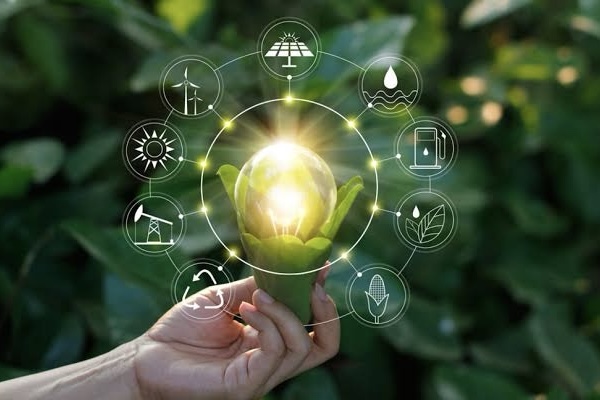
Introduction
The need for sustainable solutions has never been greater as humanity faces the twin challenges of climate change and resource depletion. Green technology, or “green tech,” is rising to this occasion by leveraging innovation to create a balance between environmental protection and economic progress. This article takes a deep dive into the major green tech innovations driving the shift toward a sustainable future and highlights the pivotal role technology plays in addressing these global challenges.
1. Key Green Tech Innovations (Expanded)
1.1 Renewable Energy Solutions
The transition from fossil fuels to renewable energy sources is at the heart of the green tech revolution.
- Solar and Wind Power:
Solar panels have evolved dramatically in recent years, achieving greater efficiency while reducing manufacturing costs. Innovations such as bifacial solar panels, which capture sunlight on both sides, and perovskite solar cells are making solar energy more efficient and affordable. Similarly, wind turbine technology has advanced with taller turbines, improved blade design, and offshore wind farms, which can harness stronger and more consistent wind patterns. - Hydropower and Ocean Energy: Hydropower, long a cornerstone of renewable energy, is now being supplemented by emerging ocean energy technologies. Tidal and wave energy converters, such as underwater turbines, use the kinetic energy of ocean currents and waves to generate power, offering a steady and predictable source of renewable energy.
- Energy Storage Systems:
The intermittency of renewable energy sources like solar and wind is being mitigated by breakthroughs in energy storage technologies. Next-generation batteries, such as lithium-sulfur, solid-state, and flow batteries, promise higher energy densities, faster charging, and longer lifespans. These innovations are critical for storing excess energy and ensuring a stable power supply.
1.2 Sustainable Transportation
The transportation sector is one of the largest contributors to greenhouse gas emissions, and green tech is transforming it to reduce its environmental impact.
- Electric Vehicles (EVs):
EVs have seen exponential growth due to advancements in battery technology, government incentives, and an expanding charging infrastructure. Companies like Tesla, BYD, and Rivian are setting benchmarks for electric mobility, while innovations like wireless charging and solid-state batteries are further enhancing EV adoption. - Hydrogen Fuel Cells:
Hydrogen-powered vehicles are emerging as a viable alternative for long-haul transportation. These vehicles emit only water vapor and are especially suitable for applications like freight transport and heavy machinery. Governments and companies are investing heavily in hydrogen production and fueling infrastructure. - Shared Mobility Solutions:
Green tech is also promoting sustainable urban mobility through ride-sharing apps, e-scooters, and electric public transport. Innovations in app-based transportation and vehicle optimization algorithms are reducing congestion and lowering emissions.
1.3 Smart Cities and IoT
Green tech is instrumental in building smart cities that optimize energy use, minimize waste, and improve urban living.
- Smart Grids:
Smart grids use IoT devices and AI to monitor and optimize electricity distribution in real-time, reducing energy waste and integrating renewable sources more effectively. These grids can adapt to changing energy demands and detect faults automatically. - Green Buildings:
Smart sensors, energy-efficient HVAC systems, and eco-friendly construction materials like cross-laminated timber (CLT) are transforming buildings into energy-efficient structures. Technologies like smart thermostats and automated lighting systems further reduce energy consumption. - Urban Farming and Vertical Agriculture:
With limited land availability, vertical farms and rooftop gardens are leveraging IoT for precision farming. Sensors and automation optimize water, nutrients, and light, reducing resource usage while maximizing crop yields
1.4 Carbon Capture and Storage (CCS)
Carbon capture and storage technologies are gaining traction as a way to combat industrial carbon emissions.
- Direct Air Capture (DAC):
Companies like Climeworks and Carbon Engineering are developing systems that pull CO2 directly from the atmosphere, which can then be stored underground or used to create carbon-neutral fuels. - Enhanced Oil Recovery:
Captured CO2 is being used to enhance oil recovery by injecting it into depleted oil fields, simultaneously reducing emissions and extracting residual oil. - Carbon-to-Product Innovations:
Captured CO2 is being repurposed into materials such as concrete, fuels, and even consumer goods like carbon-negative plastics.
1.5 Circular Economy Innovations
The circular economy aims to minimize waste and maximize resource efficiency through recycling, reuse, and sustainable production.
- Recycling and Waste Management Tech:
AI-powered robots and advanced sorting systems are revolutionizing recycling processes, improving efficiency and purity of materials recovered. Examples include innovations like the robotic arms from AMP Robotics, which can sort waste at high speeds. - Bio-Based Materials:
Researchers are developing alternatives to traditional plastics, such as biodegradable materials made from algae, corn starch, or fungi. These materials degrade naturally, reducing pollution and reliance on petroleum. - 3D Printing:
Additive manufacturing reduces material waste by creating products layer by layer, only using the exact amount of material needed. This technology is also enabling local manufacturing, reducing transportation emissions.
1.6 Sustainable Agriculture
Agriculture is being transformed by technologies that promote efficiency and reduce environmental impacts.
- Precision Agriculture:
Drones, AI, and sensors help farmers optimize irrigation, fertilization, and pest control. By monitoring soil health and weather conditions in real-time, these technologies reduce resource waste and increase crop yields. - Alternative Proteins:
Startups like Beyond Meat and Impossible Foods are leading the charge in plant-based proteins, while lab-grown meat promises to reduce the environmental footprint of traditional animal farming. These alternatives use less water, land, and energy while producing significantly fewer emissions.
2. The Role of Technology in Driving Sustainability (Expanded)
Technology acts as the backbone of green tech by enabling innovation and scalability:
- Data Analytics:
AI-powered analytics help organizations optimize resource use, predict inefficiencies, and reduce waste in real-time. - Blockchain Transparency:
Blockchain is being used to track supply chains, ensuring sustainable sourcing of raw materials and verifying carbon offsets. - Collaboration Platforms:
Cloud-based tools enable governments, businesses, and researchers to share data and collaborate on sustainability initiatives, creating a global network of innovation.
Read also: The Hyperloop: A Glimpse into the Future of Transportation
Conclusion
Green technology is not just a tool but a necessity for achieving a sustainable future. Through innovations in renewable energy, sustainable transportation, smart cities, and circular economy practices, green tech is leading the way in reducing environmental impact while driving economic growth. However, achieving a truly sustainable future requires collective efforts from governments, businesses, and individuals to adopt and scale these technologies.
By embracing green tech innovations, humanity has the opportunity to mitigate the effects of climate change, conserve vital resources, and create a world where economic progress and environmental stewardship coexist harmoniously. The time to act is now technology is ready, and the future depends on our choices today.
Buy Now
Quantum Computing for Computer Scientists

